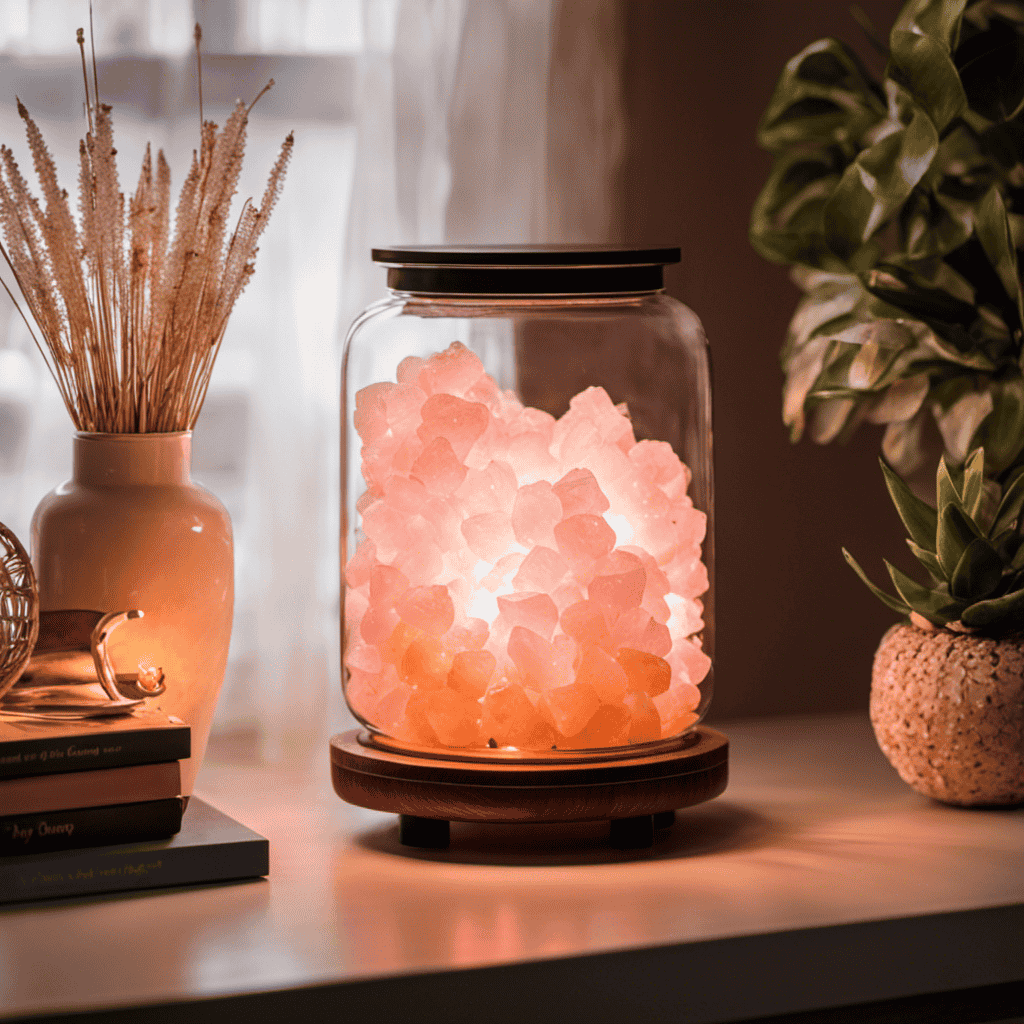As someone who owns a Dyson air purifier, I often find myself intrigued by the enigmatic figures that appear on its control panel. Deciphering these figures is akin to unlocking a hidden code, which reveals crucial information about the air quality within our living spaces.
In this article, I will guide you through the labyrinth of data, unraveling the meaning behind each number and helping you make informed decisions about the air you breathe.
So, let’s embark on this scientific journey together and demystify the numbers on your Dyson air purifier.
Key Takeaways
- The numbers on the display panel of a Dyson air purifier indicate the current level of air quality in the room, with lower numbers indicating cleaner air and higher numbers indicating poorer air quality.
- The Air Quality Index (AQI) provides information about the level of air pollution in a specific area and ranges from 0 to 500, with higher numbers indicating worse air quality.
- PM 2.5 refers to tiny particles that can penetrate deep into our lungs and bloodstream, and Dyson’s air purifiers are effective in reducing PM 2.5 levels in indoor environments.
- Dyson’s air purifiers use advanced filters and sensors, such as the HEPA filter and activated carbon filter, to capture particles and eliminate odors and harmful gases, leading to improved respiratory health and reduced allergy symptoms.
Understanding the Display Panel
The numbers on the Dyson air purifier’s display panel show you the current level of air quality in the room. These numbers are generated by the air quality sensor, which detects particles and pollutants in the air. By decoding the readings, you can better understand the cleanliness of the air you’re breathing.
The display panel typically shows a range of numbers, with lower numbers indicating cleaner air and higher numbers indicating poorer air quality. Additionally, the display panel may also feature a filter replacement indicator. This indicator notifies you when it’s time to change the filter, ensuring that your air purifier continues to effectively remove pollutants from the room.
Understanding the display panel and its numbers allows you to make informed decisions about the air quality in your environment.
Decoding the Air Quality Index (AQI
Decoding the Air Quality Index (AQI) helps us understand the current state of air pollution. The AQI is a numerical scale that provides information about the level of air pollution in a specific area. It takes into account various pollutants such as particulate matter, ozone, carbon monoxide, sulfur dioxide, and nitrogen dioxide. By understanding the AQI, we can make informed decisions about our exposure to air pollution and take necessary measures to protect our health.
Here are three things to know about decoding the AQI:
- The AQI ranges from 0 to 500, with higher numbers indicating worse air quality.
- The AQI is divided into six categories, ranging from ‘good’ to ‘hazardous,’ each with corresponding color codes for easy understanding.
- The AQI is based on standardized measurements of air pollutants and is regulated by air quality control agencies to ensure consistency and accuracy.
Interpreting the PM 2.5 Level
When it comes to air pollution, PM 2.5 refers to particulate matter that is smaller than 2.5 micrometers in diameter. These tiny particles can pose serious health risks, as they can penetrate deep into our lungs and even enter our bloodstream, leading to respiratory and cardiovascular issues.
It is crucial to address and minimize PM 2.5 levels in indoor environments, and one potential solution is using air purifiers like Dyson’s. However, to determine the effectiveness of Dyson’s air purifiers in reducing PM 2.5, we need to consider scientific data and studies that evaluate their performance in real-world scenarios.
PM 2.5 Health Risks
PM 2.5 levels can pose serious health risks, especially for individuals with respiratory conditions. These tiny particles, measuring less than 2.5 micrometers in diameter, can easily penetrate deep into our lungs, causing various health problems.
To better understand PM 2.5 health risks, consider the following:
-
Sources of PM 2.5:
-
Combustion processes like vehicle emissions and industrial activities
-
Dust and smoke from wildfires and agricultural burning
-
Chemical reactions in the atmosphere
-
Reduction methods for PM 2.5:
-
Implementing stricter emission standards for vehicles and industries
-
Promoting the use of cleaner fuels and energy sources
-
Using effective air filtration systems and air purifiers
By addressing these sources and employing reduction methods, we can help minimize PM 2.5 levels, thus reducing the associated health risks.
It’s crucial to stay informed and take necessary precautions to protect ourselves from the harmful effects of PM 2.5 pollution.
Dyson’s Air Purifier Effectiveness
To truly understand how effective Dyson’s air purifier is, consider the following factors.
Dyson’s air purification technology utilizes a combination of advanced filters and sensors to remove pollutants and improve indoor air quality. The HEPA filter is capable of capturing 99.97% of particles as small as 0.3 microns, including allergens, bacteria, and viruses. The activated carbon filter helps eliminate odors and harmful gases.
The air purifier also features a real-time air quality monitor that continuously measures and displays the levels of PM2.5 and other pollutants in the room. This data-driven approach allows users to monitor and control the air quality in their homes.
The benefits of using Dyson’s air purifier include improved respiratory health, reduced allergy symptoms, and a cleaner living environment.
Understanding the effectiveness of Dyson’s air purification technology is crucial in unraveling the VOCs measurement.
Unraveling the VOCs Measurement
When it comes to air quality, volatile organic compounds (VOCs) play a significant role. These are chemicals that can be found in common household items such as cleaning products, paints, and furniture.
Interpreting VOC measurements is crucial in understanding the level of indoor air pollution and its potential health effects. Dyson’s VOC sensor is an innovative tool that can help monitor and analyze VOC levels, providing valuable insights for improving air quality in our homes.
Vocs and Air Quality
VOCs can significantly impact the air quality in your home. These volatile organic compounds are emitted by various household products and can have detrimental effects on your health. Here are some key points to consider:
-
VOCs and allergies:
-
High levels of VOCs in the air can trigger allergic reactions, such as asthma or hay fever.
-
People with pre-existing allergies are more susceptible to the harmful effects of VOCs.
-
VOCs can worsen respiratory symptoms and lead to chronic respiratory conditions.
-
Air pollution and respiratory health:
-
VOCs contribute to indoor air pollution, which can be even more harmful than outdoor pollution.
-
Prolonged exposure to VOCs can lead to respiratory problems, including bronchitis and lung cancer.
-
Children and the elderly are particularly vulnerable to the negative effects of VOCs on respiratory health.
It is crucial to monitor and reduce VOC levels in your home to protect your respiratory well-being and overall air quality.
Interpreting VOC Measurements
Interpreting VOC measurements can be challenging without proper knowledge of what the numbers indicate.
VOCs, or volatile organic compounds, are air pollutants that can be emitted from various sources such as household products, paints, and cleaning agents. These compounds can have harmful effects on human health and the environment.
When interpreting VOC data, it is important to understand the concentration levels and potential sources of these pollutants. High VOC levels may indicate poor indoor air quality, while low levels can suggest a cleaner environment.
Additionally, analyzing trends in VOC measurements over time can provide insights into the effectiveness of air purification efforts or the presence of persistent sources.
Dyson’s VOC Sensor
Dyson’s VOC sensor helps users understand the air quality in their environment. It is a valuable tool that provides real-time data on volatile organic compounds (VOCs) present in the air.
To better understand the display panel, here are some key points:
-
The display panel shows the VOC levels in parts per billion (ppb), allowing users to easily gauge the air quality and make informed decisions.
-
The sensor measures a wide range of VOCs, including formaldehyde, benzene, and toluene, which are common indoor pollutants.
-
The display panel also provides a color-coded indicator, with green indicating good air quality, yellow for fair, and red for poor. This visual cue helps users quickly assess the situation.
By understanding the display panel and the VOC sensor readings, users can take necessary measures to improve their indoor air quality.
Now, let’s explore how to make sense of the humidity readings.
Making Sense of the Humidity Readings
The numbers on the Dyson air purifier can help you understand the current humidity levels. Maintaining optimal humidity levels is crucial for our health and comfort. Too much humidity can lead to mold growth and respiratory issues, while low humidity can cause dry skin and respiratory irritation. The Dyson air purifier provides real-time readings of the humidity levels in your environment. Understanding these numbers can help you take appropriate actions to achieve humidity control. I have created a table below to illustrate the different humidity levels and their corresponding meanings:
| Humidity Level | Meaning |
|---|---|
| 30% – 50% | Optimal range |
| Below 30% | Dry conditions |
| Above 50% | High humidity levels |
Analyzing the Fan Speed Indicator
By monitoring the fan speed indicator on the Dyson air purifier, you can easily determine the level of air circulation in your environment. The fan speed control allows you to adjust the power of the fan, giving you the ability to increase or decrease the airflow as needed.
This is especially useful in situations where you want a stronger circulation, such as during periods of high pollution or allergens. On the other hand, you can decrease the fan speed for a quieter operation, reducing the noise level in your space. The Dyson air purifier has been designed to provide efficient air purification without compromising on noise levels, ensuring a peaceful and comfortable environment.
With the fan speed indicator, you have full control over the air circulation and noise level in your surroundings, creating the perfect balance for your needs.
Now, let’s explore the timer and sleep mode functions of the Dyson air purifier.
Exploring the Timer and Sleep Mode Functions
With the timer and sleep mode functions, you can easily program the air purifier to automatically turn off or adjust its settings after a certain period of time. This feature is especially useful when you want the air purifier to run for a specific duration or when you want it to reduce its noise level during nighttime. The timer settings allow you to choose how long you want the air purifier to operate before it shuts off. On the other hand, the sleep mode benefits those who prefer a quieter and more energy-efficient operation during their sleep. In sleep mode, the air purifier runs at a lower fan speed and dimmer display, ensuring a peaceful and undisturbed sleep environment.
| Timer Settings | Sleep Mode Benefits |
|---|---|
| Set operating time | Quieter operation during sleep |
| Automatically turns off | Energy-efficient |
| Customize duration | Dimmer display |
| Convenient programming | Peaceful sleep environment |
What Do the Numbers on My Dyson Air Purifier Mean and What Does the F Mean on My Dyson Cool Air Purifier?
The numbers on your Dyson Cool Air Purifier indicate the level of air purification being provided, with higher numbers representing more powerful purification. The “F” on your Dyson Cool Air Purifier stands for fan speed, indicating the strength of the airflow. Understanding the Dyson Cool Air Purifier meaning helps optimize its use.
Frequently Asked Questions
How Often Should I Change the Filters in My Dyson Air Purifier?
I change the filters in my Dyson air purifier every 6 months. Regular maintenance ensures optimal performance and clean air. Using a Dyson air purifier has numerous benefits, such as reducing allergens and improving indoor air quality.
Can I Control My Dyson Air Purifier Remotely Using a Smartphone or Other Device?
Yes, I can control my Dyson air purifier remotely using my smartphone. This smart home integration allows me to adjust settings, monitor air quality, and schedule purification cycles from anywhere. The benefits of remote control include convenience and the ability to maintain a clean and healthy environment.
Does the Dyson Air Purifier Come With a Warranty? if So, What Is the Duration of the Warranty?
The Dyson Air Purifier comes with a warranty, but the duration may vary depending on the specific model. It is important to check the documentation or contact Dyson directly for more information on the warranty duration.
What Is the Average Lifespan of a Dyson Air Purifier?
The average lifespan of a Dyson air purifier is approximately 10 years. Regular filter replacement is recommended to maintain optimal performance and efficiency.
Is It Possible to Adjust the Airflow Direction of the Dyson Air Purifier?
Yes, it is possible to adjust the airflow direction of the Dyson Air Purifier. By changing the airflow direction, you can customize the distribution of purified air in your room, maximizing the benefits of the purifier’s adjustable settings.
Conclusion
In conclusion, understanding the numbers on a Dyson air purifier is essential for optimizing its performance. By decoding the air quality index, interpreting the PM 2.5 level, unraveling VOCs measurement, making sense of humidity readings, analyzing fan speed indicator, and exploring timer and sleep mode functions, users can effectively monitor and improve indoor air quality.
But amidst all this data, we must ask ourselves, are we truly aware of the impact our indoor environment has on our health and well-being?










